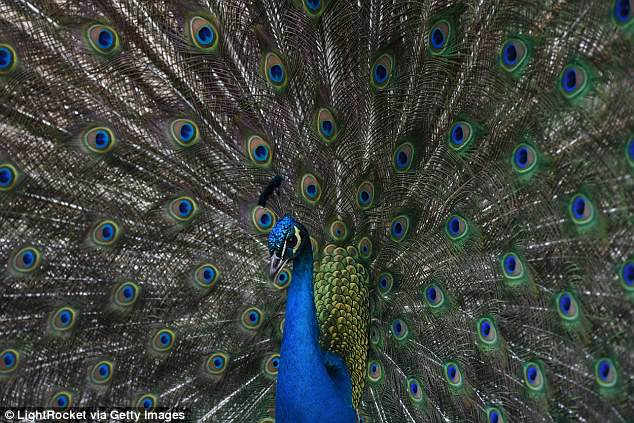Hello ladies! Male peacocks can make females’ heads vibrate from a distance with a shake of their tail feathers
The peacock’s elaborate tail feathers may be among the best known courtship displays in the animal kingdom – so, it should come as no surprise to find they’re really making heads turn in the wild, according to Daily Mail.
A new study has found that the pulsating sound created when a male peacock shakes his colorful feathers causes the crest on the female’s head to vibrate.
For now, however, it remains unclear how exactly this remarkable response plays into the mating game.
In the study researchers conducted the first measurements of the biomechanical properties of female peacocks’ crest – or the wispy feathers atop their heads.
These feathers, the researchers found, are linked to smaller feathers that act like sensors.
‘When peacock wing-shaking courtship behavior was simulated in the laboratory, the resulting airflow excited measurable vibrations of crest feathers,’ the researchers wrote in the study.
‘These results demonstrate that peafowl crests have mechanical properties that allow them to respond to airborne stimuli at the frequencies typical of this species’ social displays.’
Researchers previously identified male peacocks’ use of a phenomenon called resonant frequency, which allows them to effectively hypnotize the female.
By shaking their tails at the same speed as their natural resonance, the feathers are vibrated with the greatest amplitude but the brightly coloured eyespots remain practically motionless.
Using high-speed video, team of zoologists led by Roslyn Dakin at the University of British Columbia found that peacocks ‘stridulate’ or rattle their tail feathers at an average 25.6 Hz.
This generates a broadband, pulsating mechanical sound.
The researchers also found that males with longer train feathers had to shake faster, requiring more muscular effort.
‘Charles Darwin observed that peacocks vibrate their feathers during courtship, but it took this multidisciplinary team of scientists to characterize the dynamics of this behaviour,’ said Suzanne Kane, a co-author of the study, at the time.
The researchers now propose further behavioural studies to better explore the mechanisms at work, and how they play into the perception of these social displays.
N.H.Kh

